|
|
Post by Admin on Jul 26, 2015 1:46:17 GMT
In the new study, Johannes Krause of the Max-Planck Institute for Evolutionary Anthropology in Leipzig, Germany and an international team of colleagues took DNA from two Neanderthal males whose bones were found in a cave in Northern Spain.  The team then looked specifically for the sequence of a gene called FOXP2 among the DNA from the bones — a gene known to be related to language. It isn't clear exactly what FOXP2 does, but in humans, mutations in this gene are known to cause a severe language problem in which affected individuals cannot grasp grammar and do not have the ability to control mouth movements to make words3.  Krause expected to find that the Neanderthal version of the gene looked like the ‘ancestral’ form, as found in chimpanzees, rather than the newer human version, which differs in two places from the chimp FOXP2. But the human changes appeared in the Neanderthal DNA too. “Most, including us, would have said that this gene would have looked more ancestral,” says Krause. “The Neanderthals surprised us there a bit.” The team publish their results in Current Biology4.  It’s hard to say what this means for the linguistic aptitude of our Neanderthal cousins. “The status of FOXP2 in Neanderthals is not by itself sufficient for us to resolve the big question of whether or not they were capable of speech,” says Simon Fisher, a neuroscientist who studies FOXP2 at the University of Oxford’s Wellcome Trust Centre for Human Genetics.  The group admits that there are other possible explanations for their results: it could be that they are sampling the offspring of Neanderthal and human mating, so that humans gave the Neanderthals in question the modern FOXP2 gene. Or it could possibly be due to contamination in the field or the lab. |
|
|
|
Post by Admin on Aug 1, 2015 1:47:43 GMT
We report genome-wide data from a modern human mandible, Oase 1, found in 2002 in the Pes¸tera cu Oase, Romania. The age of this specimen has been estimated to be ,37,000–42,000 years by direct radiocarbon dating2,17,18. Oase 1 is therefore one of the earliest modern humans in Europe. Its morphology is generally modern but some aspects are consistent with Neanderthal ancestry19–21. Subsequent excavations uncovered a cranium from another, probably contemporaneous individual, Oase 2, which also carries morphological traits that could reflect admixture with Neanderthals17,19  Figure 1: Allele sharing between the Oase 1 individual and other genomes. The mtDNA sequence based on all fragments clusters with present-day Europeans (Extended Data Fig. 1) (Supplementary Note 1). In contrast, the mtDNA sequence based on deaminated fragments is related to a large group of present-day Eurasian mtDNAs (haplogroup N) but diverges from these before they diverged from each other. This Oase 1 mtDNA carries a few private mutations on the basis of which its age can be estimated to be 36,330 years before present (14,520–56,450; 95% confidence interval). Using six positions at which the mtDNA sequence differs from at least 99% of 311 present-day humans, we estimate the contamination among all mtDNA fragments to be 67% (95% confidence interval 65–69%). When we restrict to mtDNA fragments that carry terminal C-to-T substitutions, the contamination estimate is s 4% (95% confidence interval of 2–9%) (Supplementary Note 1). To isolate nuclear DNA from Oase 1, we used three sets of oligonucleotide probes that cover about two million sites that are single nucleotide polymorphisms (SNPs) in present-day humans and captured DNA molecules from the five libraries. Of the SNPs targeted, 51% (n 5 1,038,619) were covered by at least one DNA fragment, and 13% (n 5 271,326) were covered by at least one fragment with a terminal C-to-T substitution. To estimate nuclear DNA contamination, we tested whether Oase 1 DNA fragments with or without evidence of deamination share more alleles with present-day Europeans or with East Asians. We found that Europeans share significantly fewer alleles with Oase 1 fragments that are deaminated than with Oase 1 fragments that are not, consistent with European contamination of 17–30% (Supplementary Note 1). On the basis of these findings and those from mtDNA, we restricted all subsequent analyses to DNA fragments that carry terminal C-to-T substitutions. After doing this, we found that we captured targeted SNPs from the X and Y chromosomes at a similar rate, indicating that Oase 1 carried both an X and a Y chromosome and thus that he was male. The Y chromosome alleles belong to the F haplogroup, which is carried by most males in Eurasia today (Supplementary Note 2).  We find that Oase 1 shared more alleles with present-day East Asians and Native Americans than with present-day Europeans, counter to what might naively be expected for an ancient individual from Europe (Fig. 1). However, it has been suggested that Europeans after the introduction of agriculture derive a part of their ancestry from a ‘basal Eurasian’ population that separated from the initial settlers of Europe and Asia before they split from each other28. Therefore, we replaced present-day Europeans with Palaeolithic and Mesolithic European individuals in these analyses. We then find that the Oase 1 individual shares equally many alleles with these early Europeans as with present-day East Asians and Native Americans (Fig. 1). Restricting this analysis to transversion polymorphisms, which are not susceptible to errors induced by cytosine deamination, does not influence this result (Extended Data Table 2 and Supplementary Note 3). This suggests that the Oase 1 individual belonged to a population that did not contribute much, or not at all, to later Europeans. This contrasts, for example, with the ,36,000–39,000-year-old Kostenki 14 individual from western Russia, who was more closely related to later Europeans than to East Asians. We also observe more Neanderthal-like alleles in the Oase 1 individual when we compare him to four early modern humans: an 8,000-year-old individual from Luxembourg, and three individuals from Russia who vary in age between 24,000 and 45,000 years. Thus, the Oase 1 individual appears to have carried more Neanderthal-like DNA than any other modern human analysed to date. This observation cannot be explained by residual present-day human contamination among the DNA fragments that carry terminal C-to-T substitutions, because all modern humans studied to date carry less Neanderthal ancestry than the Oase 1 genome, and thus contamination would lower, rather than increase, the apparent Neanderthal ancestry.  Figure 2 | Spatial distribution of alleles matching Neanderthals in modern humans. Coloured vertical lines indicate alleles shared with Neanderthals and no colour indicates alleles shared with the great majority of West Africans. D, Dinka; F, French; H, Han; K, Kostenki 14; O, Oase 1; U, Ust’-Ishim. The seven grey bars indicate segments of putative recent Neanderthal ancestry. This analysis is based on 78,055 sites. Numbers refer to chromosomes. We plotted the positions of Neanderthal-like alleles across the Oase 1 genome (Fig. 2). We detect three segments that are over 50 centimorgans (cM) in size, suggesting that the Neanderthal contribution to the Oase 1 individual occurred so recently in his family tree that chromosomal segments of Neanderthal origin had little time to break up due to recombination. To estimate the date of the most recent Neanderthal contribution to the Oase 1 genome, we studied the size spans of seven segments of the genome that appeared to be recently derived from Neanderthals. Their genetic lengths suggest that the Oase 1 individual had a Neanderthal ancestor as a fourth-, fifth- or sixth-degree relative (Supplementary Note 5). This would predict that an average of 1.6% to 6.3% of the Oase 1 genome derived from this recent Neanderthal ancestor. Visual inspection of the Oase 1 genome suggests that in addition to these seven segments, other smaller segments also carry Neanderthal-like alleles (Fig. 2). When we remove the seven longest segments, the estimate of Neanderthal ancestry in Oase 1 drops from 7.3% to 4.8%, which is still around twice the 2.0–2.9% estimated for the French, Han, Kostenki and Ust’-Ishim individuals in this remaining part of the genome. This additional Neanderthal ancestry could reflect an older Neanderthal admixture into the ancestors of Oase 1, or that we failed to find all segments of recent Neanderthal ancestry. The Oase 1 genome shows that mixture between modern humans and Neanderthals was not limited to the first ancestors of present-day people to leave Africa, or to people in the Near East; it occurred later as well and probably in Europe. The fact that the Oase 1 individual had a Neanderthal ancestor removed by only four to six generations allows this Neanderthal admixture to be dated to less than 200 years before the time he lived. "An early modern human from Romania with a recent Neanderthal ancestor." Nature (2015) DOI: 10.1038/nature14558 |
|
|
|
Post by Admin on Aug 9, 2015 2:03:12 GMT
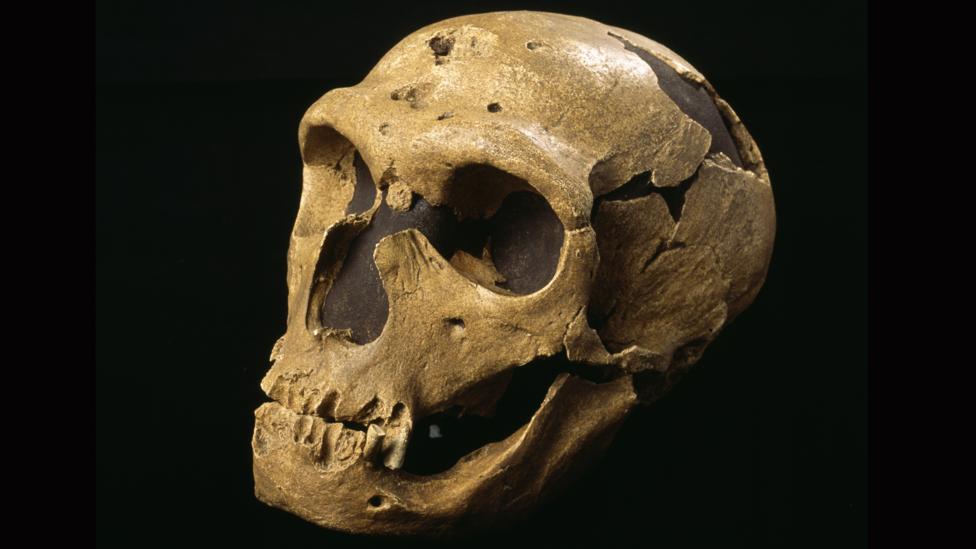 In 2013, a team led by Eiluned Pearce of the University of Oxford in the UK proposed a radical explanation: their eyes were to blame. From a detailed analysis of modern human and Neanderthal skulls, Pearce found that both their eyes and their brain's visual system were larger than ours. Their big eyes meant that they devoted a larger part of their brain to seeing. However, Pearce suggests that this came at a cost to their social world. Other parts of their brain would in turn have been smaller. "Since Neanderthals evolved at higher latitudes and also have bigger bodies than modern humans, more of the Neanderthal brain would have been dedicated to vision and body control, leaving less brain to deal with other functions like social networking," Pearce said at the time. The theory goes that, unlike us, they could not devote large parts of their brain to developing complex social networks. So when they were faced with major threats, such as a changing climate or competition from modern humans, they were at a disadvantage. Teamwork would have been vital in these situations, so if they lacked the ability to form large groups, they would not have had the support they needed. We all get by with help from our friends, but Neanderthals did not have enough friends to help out. "The substantive issue is not the opening through which the eye peers, but the area of the retina at the back," says co-author Robin Dunbar, also from the University of Oxford. Our species, on the other hand, evolved in Africa where there is plenty of light. This area is so important because it records all the incoming light from the world. Neanderthals lived in northern regions where the light was dimmer, and their large eyes may have helped them to see better. "To see more clearly, you need to gather more light into the eye, and that means having a bigger retina," says Dunbar. "The size of the retina is determined by the size of the eyeball." Because of this, Dunbar and Pearce argue, a bigger "computer" was needed to process all this additional visual information. "By analogy, there is no point in having an incredibly large radio telescope attached to a tiny computer that gets overwhelmed by the information coming in," Dunbar says.  Our species, on the other hand, evolved in Africa where there is plenty of light. We did not need such a large visual processing system. Instead we evolved a bigger frontal lobe, allowing us to develop more complex social lives. It's a neat story. But other biologists are far from convinced, and some of them have set out to unpick the idea. They have now published their findings in the American Journal of Physical Anthropology. The new analysis suggests that Neanderthals' large eyes did not contribute to their extinction after all. John Hawks of the University of Wisconsin-Madison and his colleagues looked at 18 living primate species, to find out whether the size of their eye sockets was linked to the size of their social groups.  Rather than bigger eyes resulting in smaller social groups, they found that the opposite was true. "Big eyes actually indicate bigger social groups in other primates," says Hawks. "If we could believe that logic, we would expect Neanderthals to be better social animals than we are today. Now, we don't believe any of it: we actually think that eyes have nothing to do with social groups." To truly understand how Neanderthals socialised with each other, we would be better off looking at clues from the archaeological record, says Hawks. These clues show "that they were sophisticated social beings", not socially-inept loners. Neanderthals in general were slightly larger than the average modern human. Their eyes might simply be proportionally larger in the same way as the rest of their face is. In 2012, Pearce and Dunbar showed that some modern humans living in high latitudes also have larger eyes than average. Yet the other parts of their brain are not smaller, as far as we know. "Basically, eyes don't tell you anything useful about cognitive abilities in living people," says Hawks.  The issue is further complicated by the fact that the brain is extremely interconnected. The visual cortex is involved in processing visual information, but it does not paint the whole picture of our world. How we interpret what we see is in part defined by our pre-existing knowledge of the world. For example, our memories are closely linked with our emotions. All of these cognitive processes occur in slightly different parts of the brain, and vision plays a role in them all. In other words, vision and cognition are not separate. They are "intrinsically related", says Robert Barton from Durham University in the UK, who was not involved with either study. In 1998, he showed that a larger visual area of the brain can result in the expansion of other areas, not a reduction. The truth is that after we initially perceive an object in the real world, the information is projected into several areas of the brain. "It's difficult to distinguish what particular areas of the cortex are not involved with vision," Barton says. |
|
|
|
Post by Admin on Aug 18, 2015 1:46:28 GMT
Neanderthals (Homo neanderthalensis) were widespread across Europe and Western Asia for a long time, starting about 400,000 years ago. But things began to change when populations of Homo sapiens (earlier members of our own species) migrated from Africa to Europe at about 45,000 years ago. Five thousand years later not a single Neanderthal remained. What happened? To find out, Smithsonian Science News posed a seemingly simple question to Briana Pobiner, paleoanthropologist at the Smithsonian’s National Museum of Natural History.  Q: So, why exactly did Neanderthals go extinct? Pobiner: It is hard to know exactly why many species are on the verge of extinction now, let alone species in the deep past that are already gone. However, we can assume some of the same basic ecological processes driving animals to extinction today are part of the puzzle. In the case of Neanderthals, we think competition and changes to their habitat due to climate change were two of the main factors. Neanderthals were fairly specialized to hunt large, Ice Age animals. But sometimes being specialized isn’t such a good strategy. When climates changed and some of those animals went extinct, the Neanderthals may have been more vulnerable to starvation.  We also think Homo sapiens had a competitive edge over Neanderthals. There is evidence that early Homo sapiens had long-distance trade networks, possibly buffering them against times of climate change when their preferred foods were not available; Neanderthals did not. Neanderthals had physical features that helped them survive cold climates, like large noses to humidify and warm dry, cold air and short, stout bodies to conserve heat, but early Homo sapiens had technology that Neanderthals didn’t, including sewing needles to make clothing, important during the colder periods of the Ice Ages. Homo sapiens also had innovative tools like bows and arrows and seemed to have a more diverse diet than Neanderthals. We don’t have evidence of direct combat between the two species, but we know they interacted, because they interbred. Some would say Neanderthals didn’t go extinct, because everyone alive today whose ancestry is from outside of Africa (where Neanderthals never lived) carries a little bit of Neanderthal DNA in their genes. |
|
|
|
Post by Admin on Aug 27, 2015 1:31:02 GMT
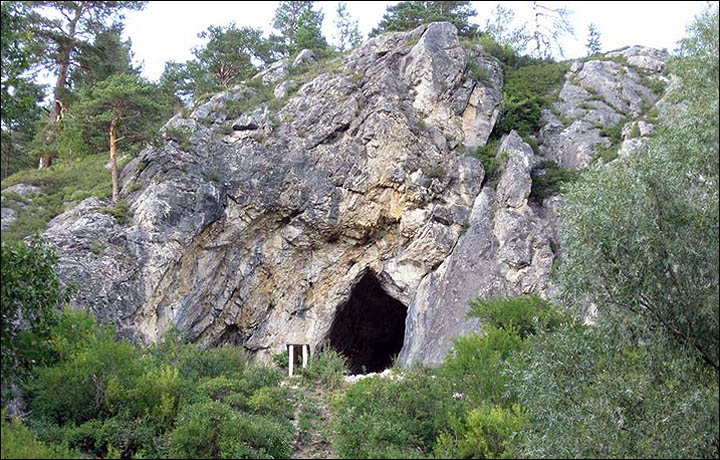 Fragments of an early human skull and rib were found in Pleistocene era layers in Strashnaya Cave, it was announced today by Professor Andrey Krivoshapkin, head of Archeology and Ethnography at Novosibirsk State University. These are expected to be 'no younger than 50,000 years' old, he said. Another find, dating to at least 35,000 years ago, was a tiny fragment of finger bone - a nail phalange. 'We struck really lucky this year,' he said. 'During works at Pleistocene levels of Strashnaya Cave we found new anthropological material. In levels dating to 35,000 to 40,000 years ago, we found a fragment of a human nail phalanx. 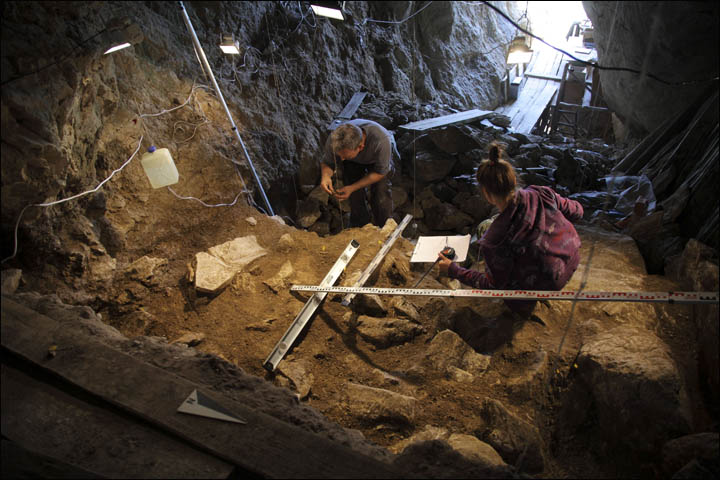 'Further down (in older layers) there was a fragment of a human skull and, even further, a fragment of a rib which we believe is human.' He stated: 'Both the skull and the rib should be no younger than 50,000 years old.' The discoveries have led to palpable excitement among scientists in Siberia.  The academic said that 'in an ideal world we would like to have the nail phalange to belong to a modern man, carrying genes of both Neanderthal and Denisovan man, and the older find (the skull) belonging to Neanderthal Man, and the oldest fragment - the rib - to be from Denisovan man.' However, he cautioned: 'Right now, however these are just my fantasies. As we know, analysis results might turn out to be completely unexpected. But whatever the results, they will help us understand the interaction of modern humans, Neanderthals and Denisovans in the Altai territory.' 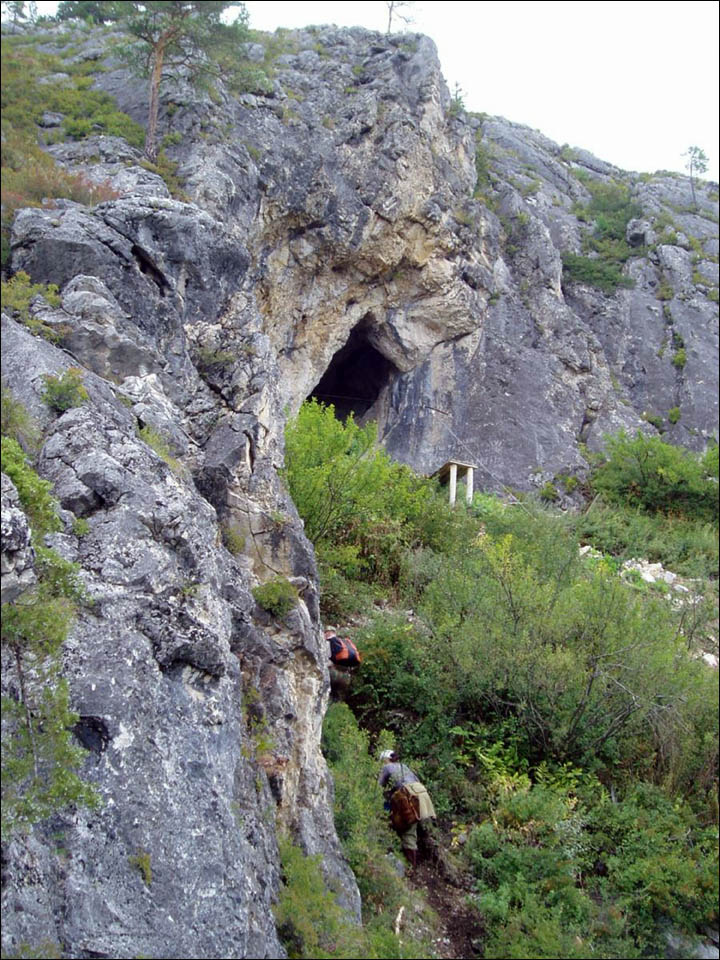 It is the first discovery of man's remains at the cave for more than a quarter of a century. In 1989, archeologists found human teeth dating to the Upper Paleolithic period, around 20,000 years ago. The skull fragment was found alongside 'labour tools' which match previously discovered implements confirmed as belong to Neanderthals, he said. The cave stands on the left bank of the River Inya, some 2.5 km north of Tigiryok village in Altai region. Earlier excavations here found variety of Stone Age tools along with Bronze, Iron and Middle Ages pottery. 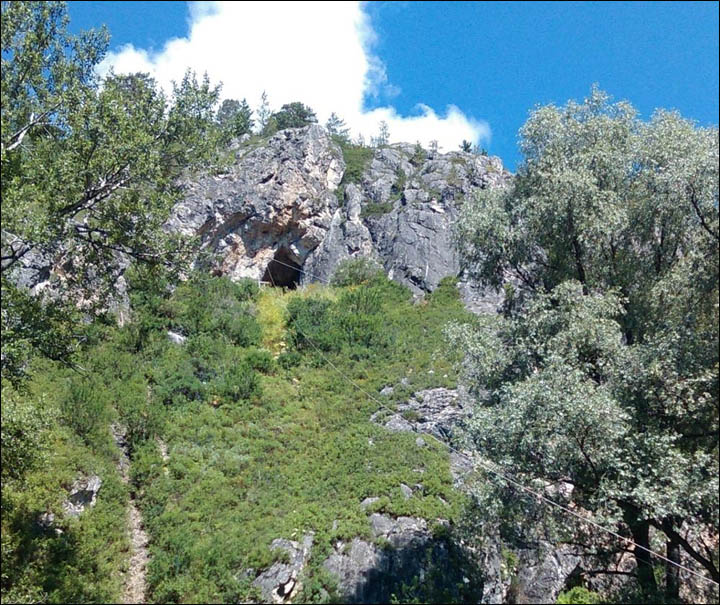 The cave is around 125 kilometres west of the more famous Denisova Cave which changed our understanding of the origins of man. Denisova was home through many millennia to both Neanderthals and our modern human ancestors. It was here that, in 2008, a tiny finger bone fragment of so-called 'X woman' was discovered, a young female who lived around 41,000 years ago, analysis of which indicated that she was genetically distinct from both Neanderthals and modern humans. This previously unknown hominin species or subspecies - long extinct - was christened the Denisovans after the name of this cave. One conclusion from analysis of ancient bone fragments is that our own species, Homo sapiens, occasionally had assignations with both Neanderthals and Denisovans. |
|


















